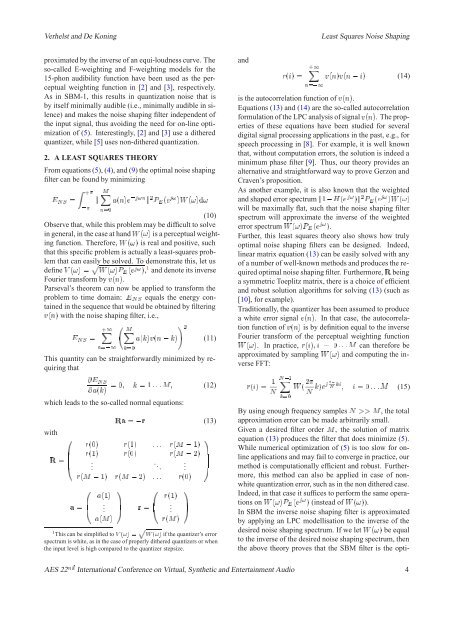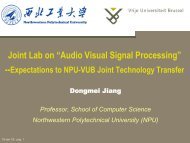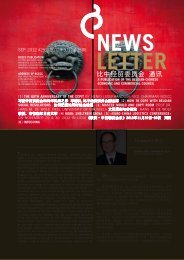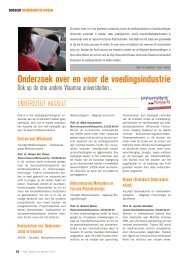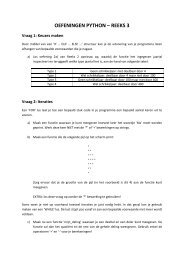least squares theory and design of optimal noise shaping filters
least squares theory and design of optimal noise shaping filters
least squares theory and design of optimal noise shaping filters
Create successful ePaper yourself
Turn your PDF publications into a flip-book with our unique Google optimized e-Paper software.
Verhelst <strong>and</strong> De Koning Least Squares Noise Shaping<br />
proximated by the inverse <strong>of</strong> an equi-loudness curve. The<br />
so-called E-weighting <strong>and</strong> F-weighting models for the<br />
15-phon audibility function have been used as the perceptual<br />
weighting function in [2] <strong>and</strong> [3], respectively.<br />
As in SBM-1, this results in quantization <strong>noise</strong> that is<br />
by itself minimally audible (i.e., minimally audible in silence)<br />
<strong>and</strong> makes the <strong>noise</strong> <strong>shaping</strong> filter independent <strong>of</strong><br />
the input signal, thus avoiding the need for on-line optimization<br />
<strong>of</strong> (5). Interestingly, [2] <strong>and</strong> [3] use a dithered<br />
quantizer, while [5] uses non-dithered quantization.<br />
2. A LEAST SQUARES THEORY<br />
From equations (5), (4), <strong>and</strong> (9) the <strong>optimal</strong> <strong>noise</strong> <strong>shaping</strong><br />
filter can be found by minimizing<br />
� � �<br />
�ÆË � � � Ò �<br />
� Ò�<br />
��Ò � È� � �� Ï � ��<br />
(10)<br />
Observe that, while this problem may be difficult to solve<br />
in general, in the case at h<strong>and</strong> Ï � is a perceptual weighting<br />
function. Therefore, Ï � is real <strong>and</strong> positive, such<br />
that this specific problem is actually a <strong>least</strong>-<strong>squares</strong> problem<br />
that can easily Ô be solved. To demonstrate this, let us<br />
define Î � � Ï � È� ��� , 1 <strong>and</strong> denote its inverse<br />
Fourier transform by Ú Ò .<br />
Parseval’s theorem can now be applied to transform the<br />
problem to time domain: �ÆË equals the energy contained<br />
in the sequence that would be obtained by filtering<br />
Ú Ò with the <strong>noise</strong> <strong>shaping</strong> filter, i.e.,<br />
�ÆË �<br />
�<br />
Ò�<br />
� �<br />
��<br />
� � Ú Ò �<br />
�<br />
(11)<br />
This quantity can be straightforwardly minimized by requiring<br />
that<br />
�ÆË<br />
� �<br />
� � � � ���� (12)<br />
which leads to the so-called normal equations:<br />
with<br />
Ê �<br />
�<br />
�<br />
�<br />
Ê� � Ö (13)<br />
Ö Ö ��� Ö Å<br />
Ö Ö Ö Å<br />
.<br />
. .. .<br />
Ö Å Ö Å ��� Ö<br />
�<br />
� � � .<br />
� Å<br />
Ö<br />
�<br />
�<br />
� Ö � .<br />
Ö Å<br />
�<br />
�<br />
�<br />
�<br />
�<br />
�<br />
1 This can be simplified to Î � � Ô Ï � if the quantizer’s error<br />
spectrum is white, as in the case <strong>of</strong> properly dithered quantizers or when<br />
the input level is high compared to the quantizer stepsize.<br />
<strong>and</strong><br />
Ö � �<br />
�<br />
Ò�<br />
Ú Ò Ú Ò � (14)<br />
is the autocorrelation function <strong>of</strong> Ú Ò .<br />
Equations (13) <strong>and</strong> (14) are the so-called autocorrelation<br />
formulation <strong>of</strong> the LPC analysis <strong>of</strong> signal Ú Ò . The properties<br />
<strong>of</strong> these equations have been studied for several<br />
digital signal processing applications in the past, e.g., for<br />
speech processing in [8]. For example, it is well known<br />
that, without computation errors, the solution is indeed a<br />
minimum phase filter [9]. Thus, our <strong>theory</strong> provides an<br />
alternative <strong>and</strong> straightforward way to prove Gerzon <strong>and</strong><br />
Craven’s proposition.<br />
As another example, it is also known that the weighted<br />
<strong>and</strong> shaped error spectrum � À � �� � È� � �� Ï �<br />
will be maximally flat, such that the <strong>noise</strong> <strong>shaping</strong> filter<br />
spectrum will approximate the inverse <strong>of</strong> the weighted<br />
error spectrum Ï � È� � �� .<br />
Further, this <strong>least</strong> <strong>squares</strong> <strong>theory</strong> also shows how truly<br />
<strong>optimal</strong> <strong>noise</strong> <strong>shaping</strong> <strong>filters</strong> can be <strong>design</strong>ed. Indeed,<br />
linear matrix equation (13) can be easily solved with any<br />
<strong>of</strong> a number <strong>of</strong> well-known methods <strong>and</strong> produces the required<br />
<strong>optimal</strong> <strong>noise</strong> <strong>shaping</strong> filter. Furthermore, Ê being<br />
a symmetric Toeplitz matrix, there is a choice <strong>of</strong> efficient<br />
<strong>and</strong> robust solution algorithms for solving (13) (such as<br />
[10], for example).<br />
Traditionally, the quantizer has been assumed to produce<br />
a white error signal � Ò . In that case, the autocorrelation<br />
function <strong>of</strong> Ú Ò is by definition equal to the inverse<br />
Fourier transform <strong>of</strong> the perceptual weighting function<br />
Ï � . In practice, Ö � �� � ���Å can therefore be<br />
approximated by sampling Ï � <strong>and</strong> computing the inverse<br />
FFT:<br />
Ö � � Æ<br />
Æ �<br />
��<br />
Ï �<br />
Æ � �� � Æ �� � � � ���Å (15)<br />
By using enough frequency samples Æ �� Å, the total<br />
approximation error can be made arbitrarily small.<br />
Given a desired filter order Å, the solution <strong>of</strong> matrix<br />
equation (13) produces the filter that does minimize (5).<br />
While numerical optimization <strong>of</strong> (5) is too slow for online<br />
applications <strong>and</strong> may fail to converge in practice, our<br />
method is computationally efficient <strong>and</strong> robust. Furthermore,<br />
this method can also be applied in case <strong>of</strong> nonwhite<br />
quantization error, such as in the non dithered case.<br />
Indeed, in that case it suffices to perform the same operations<br />
on Ï � È� � �� (instead <strong>of</strong> Ï � ).<br />
In SBM the inverse <strong>noise</strong> <strong>shaping</strong> filter is approximated<br />
by applying an LPC modellisation to the inverse <strong>of</strong> the<br />
desired <strong>noise</strong> <strong>shaping</strong> spectrum. If we let Ï � be equal<br />
to the inverse <strong>of</strong> the desired <strong>noise</strong> <strong>shaping</strong> spectrum, then<br />
the above <strong>theory</strong> proves that the SBM filter is the opti-<br />
AES 22 Ò� International Conference on Virtual, Synthetic <strong>and</strong> Entertainment Audio 4


